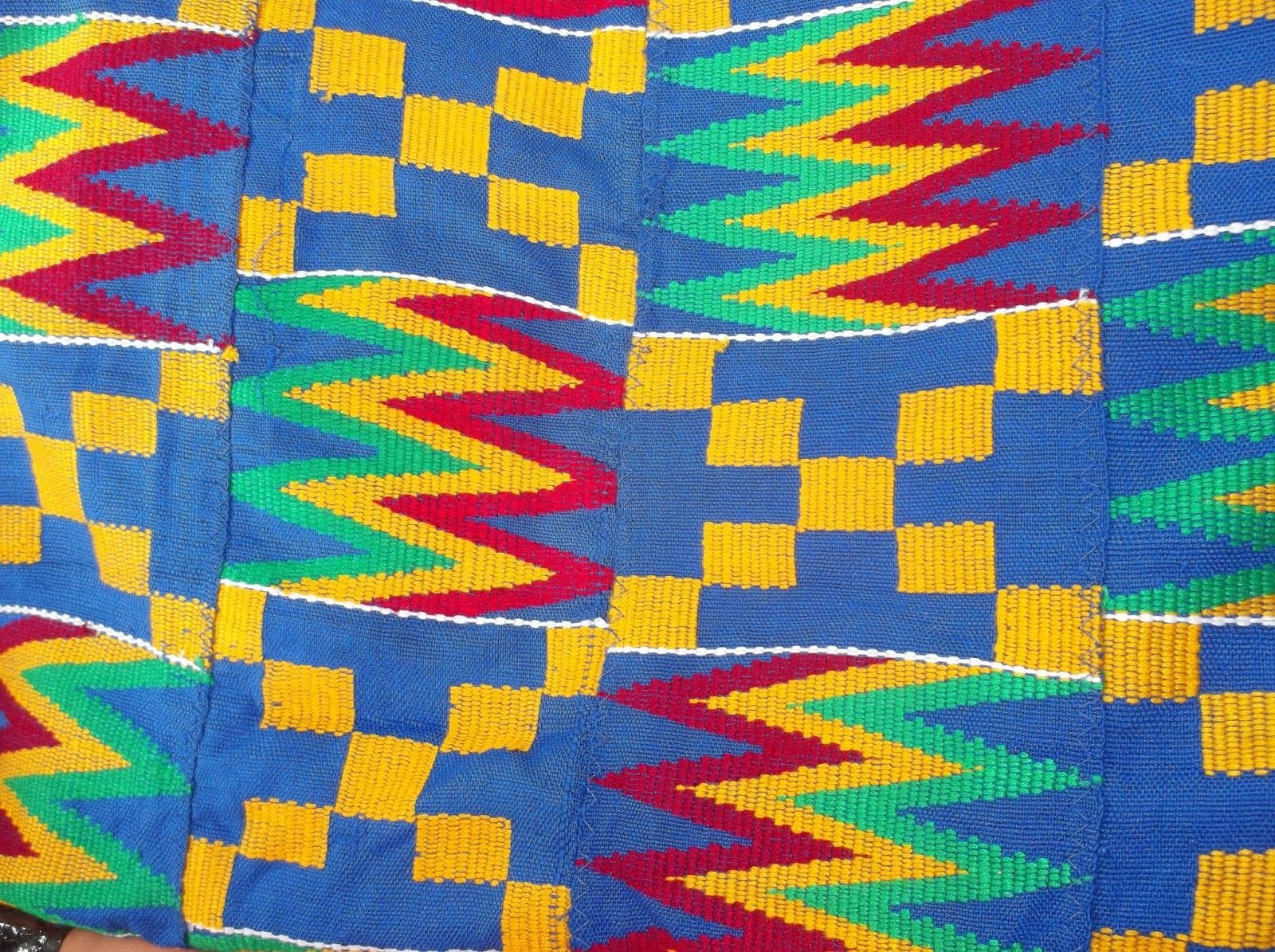Ever seen cloth that tells a story? That’s Kente. This vibrant, handwoven textile from Ghana and the Ivory Coast isn’t just fabric; it’s a visual language. Each color, each geometric pattern, whispers tales of history, beliefs, and traditions. Think of it like a secret code, woven into threads. From social status to spiritual beliefs, Kente cloth speaks volumes. Come explore this amazing art form with us. We’ll dive into its history, meet the skilled weavers, and uncover the hidden meanings behind those eye-catching designs. We’ll even look at the two main types—Asante and Ewe—and see how their unique patterns tell different stories. Get ready to unravel the threads of Kente and discover the rich cultural heritage woven within.
A Royal History: From Humble Threads to Regal Symbolism
The story of Kente likely begins centuries ago, shrouded in captivating legends. One popular tale suggests its design was inspired by two friends observing a spider’s intricate web, sparking the idea to recreate the pattern on a loom. Though the exact origins remain a subject of ongoing research, what’s evident is Kente’s remarkable journey from everyday wear to a powerful emblem of royalty and authority among the Ashanti people. This transformation, probably aided by access to finer materials like silk, elevated Kente beyond mere clothing. It became a living testament to Ashanti culture and a symbol of their rich heritage.
The Weaver’s Art: A Legacy Passed Through Generations
Creating Kente is more than just weaving; it’s an art form passed down through families, a legacy carefully preserved. Skilled artisans, predominantly men, work with focused precision on traditional looms, interlacing silk and cotton threads to create intricate geometric motifs. Imagine the patience and expertise demanded by this meticulous process, each thread a brushstroke in a vibrant tapestry of color and meaning. The rhythmic clatter of the loom and the careful movements of the shuttle create not just cloth, but a living embodiment of Ashanti heritage. This time-honored tradition is a testament to the enduring power of human creativity.
Deciphering the Designs: Unlocking the Secrets of Kente’s Patterns
Beyond their aesthetic appeal, Kente patterns pulse with symbolic meaning. These aren’t random designs; they’re visual representations of proverbs, historical events, social roles, and abstract concepts. Each motif carries a unique narrative, contributing to a complex language woven into the very fabric. For example, the “Ladder of Success” pattern embodies ambition and perseverance, while the “King’s Stool” motif signifies authority and the foundation of Ashanti power. Exploring these patterns is like learning a new language, a gateway into the rich cultural heritage encoded within Kente cloth. Some experts believe that ongoing research may reveal further nuances in the meaning of these patterns, offering deeper insight into the ever-evolving story of Kente.
The Language of Color: Adding Depth to the Woven Narrative
Kente’s vibrancy extends beyond its intricate patterns. The colors themselves possess symbolic significance, deepening the cloth’s narrative. Gold, often associated with royalty, suggests wealth and spiritual purity. Blue may represent love, harmony, and good fortune, while green likely symbolizes growth and renewal, mirroring nature’s vitality. Red, potent in many cultures, often signifies passion, sacrifice, and the spiritual link to ancestors. This interplay of color and pattern creates a powerful visual language, transforming Kente cloth into a dynamic expression of Ashanti culture.
Kente in the Modern World: A Global Celebration of Heritage
Kente has transcended its traditional role to become a global symbol of African heritage and pride. From high-fashion runways to everyday wardrobes and home decor, Kente patterns now resonate with diverse audiences worldwide. This global embrace raises important questions about cultural appropriation and the importance of respecting the traditions behind these designs. While Kente’s contemporary adaptations are a testament to its enduring appeal, preserving its cultural heritage requires thoughtful engagement and a commitment to honoring its origins.
Caring for Kente: Preserving a Piece of History
Owning Kente cloth is like holding a piece of history. Proper care ensures its beauty and cultural significance endure. Authentic Kente requires gentle handling. Handwashing with mild soap and air drying are generally recommended to protect the delicate fibers and vibrant colors. Proper storage, away from dust, light, and insects, is also crucial. By caring for your Kente, you contribute to preserving a valuable piece of cultural heritage for future generations.
A Glimpse into Kente’s Visual Vocabulary
| Pattern Name | Symbolic Meaning | Common Colors Used |
|---|---|---|
| Adinkrahene | Chieftaincy, leadership, greatness, charisma | Gold, Black, Red |
| Aya | Fern (endurance and resourcefulness) | Green, Yellow |
| Sika Fre Mogya | Money attracts blood (cautionary message about greed) | Gold, Red |
| Nkyimkyim | Twisted threads (complexities of life) | Various |
| Obanyansoro | Community support and encouragement | Black, White, Yellow |
This table provides a mere glimpse into the vast vocabulary of Kente patterns. With over 350 documented designs, each carrying its unique story, the world of Kente offers endless opportunities for exploration and deeper understanding of Ashanti culture.
Exploring the Depths of Kente’s Symbolism
Kente’s intricate designs, numbering over 350, are more than just decoration; they are symbolic narratives of Ashanti heritage, encompassing proverbs, historical events, social roles, and abstract ideas. This intricate visual language transforms the cloth into a living history book, each chapter meticulously woven in vibrant hues and intricate designs. The symbolism extends beyond the patterns to the colors themselves. Black, often representing the African continent, anchors Ashanti identity. Red, symbolizing ancestral blood, connects the wearer to their lineage. Yellow, reminiscent of gold, suggests wealth and royal status, while green evokes the land’s abundance. This rich interplay of symbols creates a dynamic expression of Ashanti culture.
Kente’s journey, from royal attire to a global symbol of African heritage, speaks to its enduring power. The rhythmic clatter of the loom and the meticulous interlacing of threads are echoes of a centuries-old tradition, connecting us to the past. While traditional meanings hold significance, ongoing research suggests evolving interpretations, adding complexity to this rich textile tradition. The possibility of new designs reflecting contemporary events further highlights Kente’s dynamic nature.
Kente’s Spiritual Resonance: A Connection to the Divine
Kente cloth is not merely aesthetically pleasing; it holds deep spiritual meaning for the Ashanti people. It serves as a spiritual link to ancestors, community, and the divine, fostering a sense of belonging and continuity. Wearing kente can be a deeply personal spiritual practice, connecting the wearer to their heritage. The patterns and colors hold symbolic weight, with gold representing spiritual purity and black signifying spiritual energy and ancestral connection. Even the act of weaving kente is a spiritual practice, transforming simple threads into a powerful symbol of cultural identity and spiritual connection.
Asante and Ewe Kente: Distinct Dialects of a Woven Language
Just as language has dialects, Kente cloth boasts distinct variations, most notably Asante and Ewe. Asante Kente, often linked to royalty, features bold geometric patterns rich with symbolism. Ewe Kente, while sharing similarities, incorporates figurative elements and a broader color palette, reflecting a close relationship with nature. Both types are created using intricate weaving techniques, showcasing the artistry and skill of the weavers. The patterns and colors carry symbolic meanings, with interpretations sometimes varying by region or community. Today, Kente’s influence is global, seen in fashion and art worldwide. However, respecting its cultural heritage and supporting traditional weavers remain crucial for its continued thriving. Ongoing research continues to unveil new insights into this fascinating textile tradition.
Kellerman’s Resort
metaphysical meaning of woodpecker









